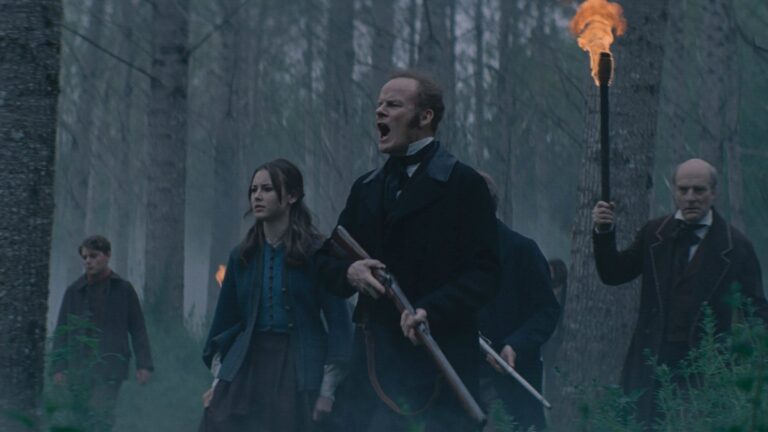Premiering at the 2021 Sundance Film Festival, Eight for Silver — the latest from director Sean Ellis (Anthropoid) — is an atmospheric thriller about a remote village being terrorized by a vicious creature in late 1800s France. The film has been warmly received by festival audiences, with Ellis garnering praise for trying to freshen up the werewolf mythology — even though that wasn’t his original intention.
“I couldn’t make Eight for Silver by saying it’s a reimagining of the werewolf,” Ellis told us via telephone last week, just days before the film’s inaugural screening. “Creatively, I didn’t know how to reinvent it. We all know that on a full moon, if you’ve been bitten by a wolf then you sprout fangs, and grow hair, and howl at the moon. We also know that a silver bullet can kill a werewolf — we don’t know why, but there we go.”
Instead, Ellis chose to focus less on the creature, and more on thematic elements that an audience might be able to latch into. “I had the atmosphere of what it was: winter, the countryside in France, a village, an unseen force, a curse of some kind. I started to think about the thing that was really plaguing the village: it was addiction. Let’s see what addiction does to families, and what it does to communities.”
From there, the writing began to take off, and Ellis made a conscious decision to approach the creature in a way he felt hadn’t been done before. The monster in Eight for Silver wouldn’t be something that his characters changed into: they would be a prisoner to it.
“At certain points, we called it The Dark Passenger,” said Ellis, referencing (perhaps unknowingly) the force that drove Michael C. Hall to become a serial murderer in Showtime’s Dexter. “It’s the thing that makes you do something even though you don’t want to do it. When I started to think of it in those terms, that was where the design element came from.”
The design went through multiple iterations over the course of the film’s shooting schedule, which featured a months-long break in the middle. Production company LD Entertainment didn’t want to shoot in the summer, so Ellis and his team shot for several weeks at the beginning of 2019, leaving some additional material to be completed at the end of the year.
“Toward the end of that year we looked at what we had, and we could see where the strengths were and where the weaknesses were,” said Ellis. “I started rewriting pages in order to enhance its strengths, and started to move certain parts of the narrative around. And we developed a much different ending than what was originally in the film.”
As for the creature, Ellis and his team shot with multiple practical versions on set, including a full animatronic capable of a wide range of facial expressions, and an “attack” version used in Eight for Silver‘s action-heavy sequences. Some digital wizardry was applied in post-production to create the savage monster seen in the finished film.
“I just wanted to feel like we were presenting something that was fresh and new,” said Ellis of the creature design. “If the audience looks at it and says ‘I haven’t seen that before,’ then it’s immensely satisfying, so it was quite exciting to see [the beast] start to come alive.”
Due to the ongoing COVID-19 pandemic, Eight for Silver went through a lengthy post-production timeline, and Sundance will mark the first time anyone outside of Ellis and his team have viewed the film — something he was admittedly a bit nervous about.
“We only finished it a few days before we delivered it,” he told me.”We didn’t really know what we had. Because of the circumstances, we didn’t test it, nobody’s seen it, so we’ve been alone with the film for so long. Then suddenly, we’re at Sundance.”
“That’s a good sign, isn’t it?” he laughed.
Eight for Silver premiered at the 2021 Sundance Film Festival. Find more of our 2021 Sundance Film Festival coverage at this link.

